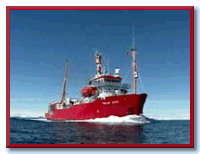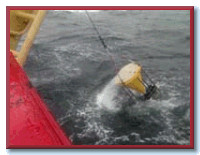|
From: Deane Rink, aboard the R/V Polar Duke (Deane is Video Producer and leader of the LFA 2 field team.) Days on the Duke
Continual seasickness, exacerbated by trying to type while waves roll
over the fantail, make time-saving devices like clipped phraseology and
occasional abbrevs. imperative. You'all may have noticed that, after rather voluminous correspondence
during first half of my Antarctic trek, there's been a drop-off in quantity
over recent weeks. (ed. Deane was working out of McMurdo on another LFA-related
project, including documenting the search for meteorites out in the Allan
Hills.) This all due to transition from McMurdo side of continent to Palmer
side, on the Antarctic peninsula just below South America's fabled Cape
Horn. I flew the great circle route (McMurdo-Christchurch-Auckland-L.A.-Miami-Santiago-Punta
Arenas) in four forgettable blurry days around 12/11-15 and arrived at Punta
Arenas in Tierra del Fuego with most luggage if not brains intact. Spent
three days in this once-lovely, now decaying port town, preparing to sail
on the Polar Duke in one of its last great Antarctic runs. (Duke's 10-year
charter ends in mid-'97 and it will be replaced by a new research vessel,
the L. M. Gould, chartered out of Louisiana, run by Cajuns but designed
to ply Antarctic waters for the next couple of decades for NSF) Duke will
probably end up working Arctic waters out of Newfoundland, though it is
Norwegian-owned and crewed. Finally we sailed about a week ago, and spent the first two days crossing
the infamous Drake Passage, where Atlantic and Pacific Oceans converge,
choppiest waters in the world. Being the brave soul, I decided to try this
crossing without chemical aids to combat seasickness, and ended up . . .mucho
nauseated, unable to type, unable to read, unable to eat, unable to sleep,
but I got very good at lying in my cramped bunk (Are Norwegians all 5'6"
or what?) staring at the ceiling, rolling with the gentle swells until the
next pang of nausea hit, and I had to limp to sink or bathroom to, well,
you can guess. Now of course this was made even worse by the quality of
the food the Chilean cooks serve up for their Norwegian masters. If it ain't
hot salsa, it's lutefisk, about the foulest, oiliest, grimiest food known
to man (of course, maritime man is a very different breed, something I've
learned painfully over the course of more than a few nautical ventures over
my life's dappled span).
Finally we hit the inner passage, the Bransfield and Gerlache Straits
that run the west side of the Antarctic Peninsula, and things calmed down
enough for me to be able to occasionally stroll the decks and take in the
fine scenery. About a day north of Palmer Station, we stopped to retrieve
sediment traps that were left there a year ago, something made possible
by radio transponders and GPS location-marking, since these traps are submerged
100 meters under the surface, collecting falling detritus of once-living
small organisms. Each trap is anchored in place by a series of six flotation
buoys, that don't really float, but instead keep the traps at the desired
depth despite changes in current, etc. I went out onto the fantail to watch
this activity and was recruited into operating the streamer winch line,
taking my cues from the marine science tech who stood, roped off for safety,
at the edge of the stern, directing the complicated pulley operations. My
streamer winch was one of three mechanical devices used to get the traps;
there were also two cranes operated by the Norwegians, all rigged up with
block and tackle pulleys. We were hauling in polypropelene ropes that had been in the waters for
a year, and right at the time we had the six flotation buoys (all plastic,
about the size of a large watermelon) at the apogee of the crane's reach,
just as the trap itself was rising from the waters, the rope snapped, sending
these six unguided missles crashing down onto the fantail, shattering the
glass transponder works inside them all over the deck. These buoys missed
the six or seven folk on the deck by inches, and caused me to worry that
my inexperience on the streamer winch had somehow caused the mishap. Fortunately
no one was hit by these falling bodies, just a good scare, but it left tensions
frayed between Norsemen and Americans, between deckhands and scientists,
between old salts and rookies like myself. The next day, the stentophone
in my room boomed out a command to be present in the ship's lounge for a
post-mortem (read: trial at sea) on what happened. I went, still not knowing
if my actions had in any way contributed to this accident and near-tragedy,
and participated with about seven others in a thorough assessment of what
had happened. I breathed a sigh of relief when it became clear that it was
the crane operator who had failed to see the hand signals by the on-deck
activity coordinator and had pulled his part of the polypro rope too far,
stretching it beyond its saturated breaking point. Gary, the on-deck coordinator,
knew that yelling at him at the moment of impact would have just made the
situation worse, so waited till this post-mortem session to air his grievances.
Part of the problem was that Gary had to be directing the operation on the
fantail while simultaneously talking by radio to the bridge, as the ship's
manuevers were also a critical part of the sediment trap recovery plan.
Cleared, I was happy, but left wondering how I, a landlubber at best,
got recruited into operating a winch I had never touched before, by reading
hand signals from busy deckhands, signals that I had never seen on the streets
of L.A. before. The actual answer is simple; I was standing closest to the
winch when the operation began, and like everybody in a dangerous situation
(of which the Antarctic holds many and it becomes second nature to pitch
in with enthusiasm, even if without the necessary skills), was expected
to throw my heart and soul into whatever action was deemed necessary to
make that situation work. That hurdle having passed, we finally landed at Palmer Station, which
will be my home for the next six or seven weeks. But I could only stay for
six hours, as the Polar Duke was sailing southwards to Rothera, the British
Antarctic Survey research station, and this cruise, on which I am now on
(we debark at Rothera in 2 hours) would be only three days before heading
back to Palmer and would accord us an opportunity to film the Duke cutting
through thick brash ice, passing by gigantic icebergs that never seem to
get as far north as Palmer, etc. It has been worth the extra seasickness;
the scenery has been spectacular, and we have rolled off over two hours
of irreproducible scenics from the bridge and decks of the ship. Of course, the cameras were not rolling when the most spectacular sighting
was made, by Tony Amos of UTexas. He happened to be on deck when a huge
berg "turtled," or rolled over due to its inherent instability
in the water. The roll over created a giant wave that actually swamped the
Duke's lower deck, making us heedful of the warning that we shouldn't pass
too close to these big, majestic bergs because one never knows when they
will tip, calve, or break into lesser parts. There's a rule at Palmer Station that one must never take zodiacs (the
small inflatable boats that we use for local travel there) closer than 200
meters to the ever-calving glaciers on Anvers Island that surround the embayments
near Palmer. Now I know why, and will respect this rule, even if I sometimes
treat other rules as approximate guidelines to be skirted when necessary.
Indeed, most of the rules of the sea, including blind allegiance to the
whims of a captain, are a lot more understandable in the light of the inherent
dangers that lurk therein, in the light of the harshness of a sailor's life,
so much different than our coddled, protected creature-comforted lives on
land. (This even gives me new insights on my Dad, who spent three of the
war years on a destroyer in the Pacific; I never understood why he wouldn't
talk of those days, when I as a kid wanted all his tales of adventure. Now
I know. He had to endure the rigors of maritime life under military hierarchies
-- more strict than my Norwegian experiences, I'm sure -- while the enemy
was shooting at him and running kamikazes and torpedoes his way. It was
not a favorite experience of his life, and he didn't want his only kid enamored
by the romance of the sea, a courtship that is more celebrated by landlubbers
in books than it is by working seamen on the waves) Speaking of which, about six hours ago, we crossed the Antarctic Circle,
which always creates a hazing ceremony for the first-timers, and Scott,
my cameraman, though he has spent two years below the Circle on land in
McMurdo, has been informed that that doesn't count, he will be a part of
the hazing ritual along with a couple of others. One more strike against
the Order of Neptune. Scott is protesting that he must be able to shoot
this arcane ritual, but if I know my Norwegians, these protests will fall
on deaf ears, and Scott will be crawling through garbage and enduring sea
water, icy and bracing, thrown over him as he stumbles through this marine
version of the gauntlet. (And for all of you who might wonder, yes, I have
crossed the Antarctic Circle on a vessel before, and am therefore entitled
to sit back... rather than be tortured, this time). Well, boys and girls, that's all for now. Hope you all have a happy holiday
and celebrate it sensibly but joyously. We on the Duke will drop anchor
at Santa Claus Island (bet you didn't know where he really came from) for
Xmas and our alcohol-free zone of a ship will cease its rules for a day
as we eat a feast, drink copious toasts, and long for our loved ones back
home. |
||||
| Back to Field Journals Menu | Back to Deane Rink's Journals | Deane Rink's Journals | ||
![]()

